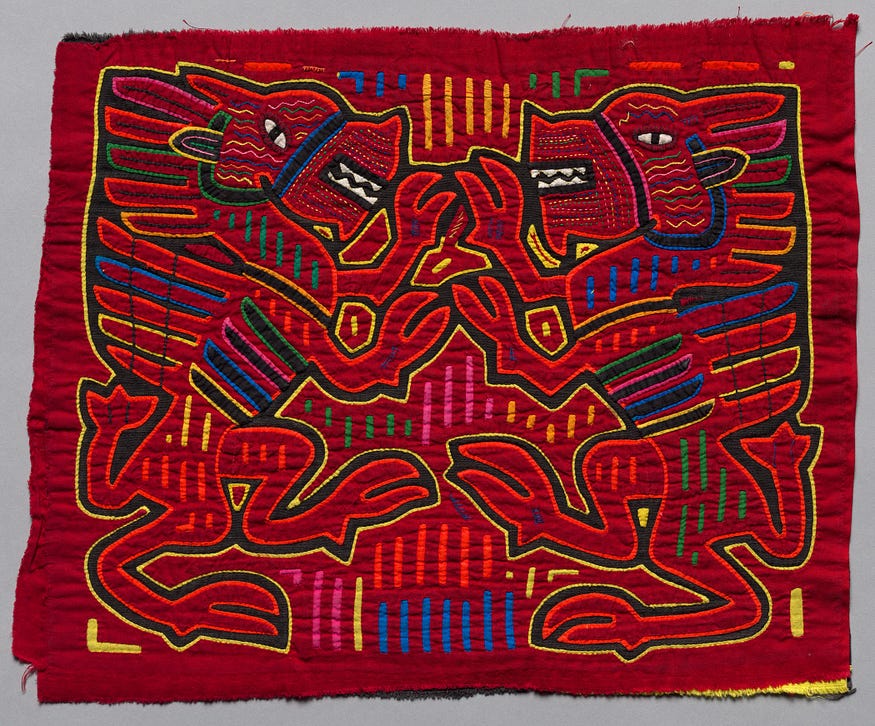The Dynamic Design of Mola Textiles
- Blog Post
- Exhibitions

If you have ever seen a mola, chances are it was displayed as a decorative panel, perhaps framed on a wall, or made into an ornamental pillow. These textiles are made from layers of colorful cotton fabric, hand cut and sewn into extravagant images and patterns that at times appear to visually vibrate. But before being repurposed as décor, mola panels are initially made in pairs and attached to separate fabric to form the front and back of a woman’s garment.

Photo: Hemis / Alamy.
The term mola means “cloth” or “clothing” and may refer to either the pair of cotton panels or the complete blouse that the panels are made for. They are made and worn by Guna women, who live along the far eastern Caribbean coastline of Panamá in an Indigenous province called Gunayala. These vibrant textiles are the subject of Fashioning Identity: Mola Textiles of Panamá, an exhibition currently on view at the Cleveland Museum of Art.

The imagery and subject matter displayed on molas varies tremendously, and at first glance it can be disorienting to know how to view these images. While some molas display abstract patterns, others have a clear subject, and some may even depict complex visual narratives. At the same time, it is easy to get lost in the density of the composition and the wild pops of color. From a distance, the flamboyant imagery of molas can appear frenzied and chaotic. Upon closer inspection, it is evident that mola artists use precise tactics to make their images stand out. With careful observation, we can appreciate the virtuosity that Guna women (opens in a new tab) demonstrate in designing and constructing such captivating graphics.
Some of the more abstract mola designs are inspired by Guna men’s basket weaving. In Basket Mola Panel (Garba Mor), serrated pink and green lines interlock across a maroon plane, itself comprising from a series of outlines.

The design field is evenly weighted, and the pattern feels continuous in every direction. Rather than a representational image, this mola displays a texturized surface of meandering lines. In contrast, Rampant Lions Mola Panel depicts a pair of zoomorphic figures set against a striped background.

Unlike Basket Mola Panel, there is a clear and stable figure-ground relationship. The heraldic lions are arranged comfortably within the frame and appear to occupy a plane that is separate from the background.
In other molas, such as Iguana Mola Panel, the figure ground-relationship is more complicated, despite the presence of a central figure.

The space around the iguana comes forward, ensconcing the iguana’s body into a dynamic field of color and line. The mola artist accomplishes this in part by filling the surrounding space with graphic elements that mimic the iguana’s body parts in size, shape, and proportion. Parallel lines of similar width and spacing, all outlined in a rainbow of colors, are used to construct the iguana’s body, tail, and dorsal crest, as well as all the spaces in between and around. The result is an energetic design that keeps the eye moving across the surface, while at the same time providing a sense of balance and stability in the central figure of the iguana.

Another common approach to making a mola design is to begin with an object from the natural environment, such as a palm tree, and deconstruct that object’s form to create a design motif that can then be copied, rotated, or flipped to compose a larger pattern. In Palm Tree Mola (below), on loan from Denison University for the exhibition, the artist appears to have done just that.

The artist has taken the palm tree form — with its tall, skinny trunk topped by a large crown of drooping fronds — and generated a new series of shapes by multiplying and reflecting sections of the tree. The yellow dots and dashes at the center of each tree’s crown may allude to coconuts, a valuable commodity and major export product of Gunayala.

Mola artists show tremendous freedom of expression, from their choice of subject matter to the extent of stylization and abstraction that may be employed in divising a finished mola design. What remains consistent is the exceptional level of skill that mola artists require to execute their designs in cut and sewn fabric.
Watch Close Looking at a Distance: Stitching Complexity for a guided exploration of a single mola, made using appliqué and reverse appliqué techniques. Learn about these processes and their complex associations with the Guna understanding of the universe.
See the craft and detail of Guna molas for yourself at the CMA. We offer gallery guides in both English and Spanish. These vibrant textiles are on view in Fashioning Identity: Mola Textiles of Panamá through January 9, 2022.